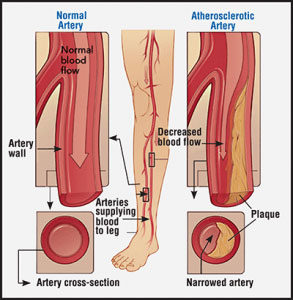
Peripheral artery disease (PAD) is caused when plaque deposits build up in the arteries. This plaque is made up of fat, cholesterol, calcium, and tissue deposited by the blood into the vessels. These deposits result in a narrowing of the arteries which restricts blood flow to the extremities and can cause numbness and discomfort. Left untreated, PAD can quickly accelerate to a condition that causes severe pain and puts you at risk for infection. In its most severe form, PAD can even lead to amputation.[i]
If you or a loved one smokes or is living with diabetes, high blood pressure, high cholesterol, or chronic kidney disease, or if you have a family history of cardiovascular disease, you have an increased risk of developing PAD. If you think you or your loved one may be at risk, it is recommended that you schedule an appointment with your primary care physician who will assess your risk factors for PAD. Your doctor may advise you to consult an interventional radiologist who specializes in treatment of PAD in an outpatient setting.
Why is it So Important to Ask My Doctor About PAD?
1. If you don’t already have PAD, your doctor can help you lower your risk.
 Your doctor can help you assess which lifestyle factors contribute to you being most at risk for developing peripheral artery disease. Certain factors, such as smoking cessation, are guaranteed to lower your risk for the disease, but the contribution of other risk factors may be difficult to determine on your own.[ii]
Your doctor can help you assess which lifestyle factors contribute to you being most at risk for developing peripheral artery disease. Certain factors, such as smoking cessation, are guaranteed to lower your risk for the disease, but the contribution of other risk factors may be difficult to determine on your own.[ii]
RELATED: 5 Things You Should Do If You Are At Risk for PAD
For example, high blood pressure, elevated cholesterol, and elevated blood glucose levels contribute to your risk of developing PAD. Depending on the severity of each condition, medications that correct these levels or prevent formation of blood clots may be required immediately to lower your risk of PAD and other conditions such as heart attack or stroke. If conditions are less severe, diet and lifestyle modifications may be all that’s required.[iii]
2. When detected early, minimally invasive treatment options are more likely to be successful.
Plaque accumulation occurs gradually over time. Increased fat and cholesterol in the diet amplify the rate at which plaque accumulates, blocking or narrowing the blood vessels faster. Detecting PAD early means that less plaque will have accumulated and treatment options are frequently far less invasive.

Treatments such as angioplasty, stenting, and atherectomy are conducted by making a small incision, usually in the groin, and threading a thin catheter through the blood vessel to the blocked area. The plaque is removed or flattened against the vessel wall, and healthy blood flow is restored. In advanced stages of PAD, more invasive treatment options, such as bypass graft surgery in the leg, may be necessary.[iv]
RELATED: 4 PAD Treatment Options That may Help Your Leg Pain
3. PAD will not go away on its own.
Left untreated, peripheral artery disease does not resolve itself. Lifestyle changes such as smoking cessation, healthy diet, and exercise will slow the progression of the disease, but once there is a buildup of plaque, it will not go away without some form of medical intervention. Ignoring peripheral artery disease will cause the blood vessels to continue to narrow over time. If the blood supply to the heart, brain, or kidney becomes blocked with plaque, heart attack, stroke, or renal artery disease can result.[v]
4. Untreated PAD can lead to gangrene, amputation, and even death.
 PAD is the leading cause of amputation in people over the age of 50.[vi] A study from Duke University reported that the rate of death after PAD-related lower extremity amputations was 48% after 1 year and 71% after 3 years. These results may be improved with new imaging techniques, but the best way to reduce risk of death is to detect PAD before amputation is necessary.[vii]
PAD is the leading cause of amputation in people over the age of 50.[vi] A study from Duke University reported that the rate of death after PAD-related lower extremity amputations was 48% after 1 year and 71% after 3 years. These results may be improved with new imaging techniques, but the best way to reduce risk of death is to detect PAD before amputation is necessary.[vii]
The Centers for Disease Control reported that approximately 8 million Americans are currently living with peripheral artery disease. This includes 1 in 5 individuals over the age of 60. One of the most startling statistics reported is that 40% of these individuals have no symptoms in the early stages of disease.[viii]
RELATED: 7 Things You Must Be Aware of If Your PAD Goes Untreated
The risk factors for PAD are well-established. If you or a loved one has multiple risk factors for peripheral artery disease, a discussion with your primary care physician or PAD specialist should be scheduled as soon as possible. Discussing ways to minimize personal risk, or considering PAD treatment options early on may avoid the invasive procedures required for advanced stage PAD, including bypass graft surgery and amputation. Ultimately, early detection and treatment of PAD can drastically improve your quality of life.
Sources:
[i] https://www.nhlbi.nih.gov/health/health-topics/topics/pad
[ii] http://content.onlinejacc.org/article.aspx?articleid=1143991
[iii] http://www.heart.org/HEARTORG/Conditions/More/PeripheralArteryDisease/Prevention-and-Treatment-of-PAD_UCM_301308_Article.jsp#.VirzyHiprFI
[iv] http://www.infopad.com/pad-treatment-options/
[v] http://my.clevelandclinic.org/services/heart/disorders/pad
[vi] http://avinger.com/patients
[vii] http://www.ncbi.nlm.nih.gov.proxy.lib.mcw.edu/pubmed/25075192
[viii] http://www.cdc.gov/dhdsp/data_statistics/fact_sheets/docs/fs_pad.pdf



